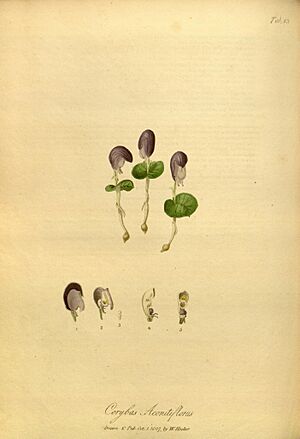Cradle orchid facts for kids
Quick facts for kids Cradle orchid |
|
|---|---|
 |
|
| Corybas aconitiflorus near Minyon Falls | |
| Scientific classification | |
| Synonyms | |
The Corybas aconitiflorus, often called the cradle orchid or spurred helmet orchid, is a special type of orchid. It grows directly from the ground and is found only in eastern Australia. You can see it from south-east Queensland down to Tasmania.
Its small flowers look like they have a hood. This is because the top part, called the uppermost sepal, covers most of the flower. This orchid is the main example for its group, known as Corybas.
Contents
What Does the Cradle Orchid Look Like?
The Cradle orchid grows from two small, round parts called tubers. These tubers help the plant store food and survive when it's not actively growing. The stems are short and stand upright.
Each plant usually has one flat, smooth leaf at its base. This leaf is dark green on top and a bit purplish underneath. It's shaped like an egg or a heart. The leaf is about 1.5 to 3.5 centimeters (0.6 to 1.4 inches) long and 1 to 3 centimeters (0.4 to 1.2 inches) wide.
The orchid has a single flower that leans forward. It is usually greyish to reddish-purple. The flower is about 2.5 to 3 centimeters (1.0 to 1.2 inches) long and 1 to 1.2 centimeters (0.4 to 0.5 inches) wide.
Flower Parts
The main part of the flower is the hooded dorsal sepal. This is the top part that looks like a hood. It's about 2.2 to 3 centimeters (0.9 to 1.2 inches) long and 1 to 1.2 centimeters (0.4 to 0.5 inches) wide. It covers and hides most of the rest of the flower.
The other sepals, called lateral sepals, and the petals are very small. They are only about 1 or 2 millimeters (0.04 to 0.08 inches) long. The labellum is another part of the flower. It's much smaller than the petals and lateral sepals. Its edges are turned inwards.
The thin column is wider at its base. It has special parts called wings along its body. Inside the flower, there are cream-colored pollen masses, called pollinia. These are sticky and attach directly to pollinators.
How it Gets Pollinated
The Cradle orchid is pollinated by fungus gnats. However, scientists don't know much about how this happens. This is because the flower is mostly hidden by the dorsal sepal. Also, this orchid is quite hard to grow outside of its natural home.
Naming the Cradle Orchid
The Cradle orchid, Corybas aconitiflorus, was first officially described in 1807. This was done by Richard Anthony Salisbury in a book called The Paradisus Londinensis. The book also featured a drawing by William Hooker.
The name of the group, Corybas, and the specific name, aconitiflorus, both describe the flower's shape. Corybas comes from an Ancient Greek word. It refers to a male dancer who wore a helmet with a crest. The flower's shape reminded people of this helmet.
The name aconitiflorus means "with a flower like Aconitum". Aconitum is another plant known as monkshood.
Changes to the Name
In 2002, some botanists suggested splitting the Corybas group into eight smaller groups. However, because Corybas aconitiflorus is the original example for the Corybas group, it will always stay in that group.
Where Does the Cradle Orchid Live?
The Cradle orchid grows in open areas with low shrubs, called heath, and in forests. It mostly lives in areas near the coast.
You can find it in Queensland, south from Gympie. It also grows in eastern New South Wales and in south-eastern Victoria. There are also a few groups of these orchids in the west of Victoria. In addition, it grows in the north and east of Tasmania.


